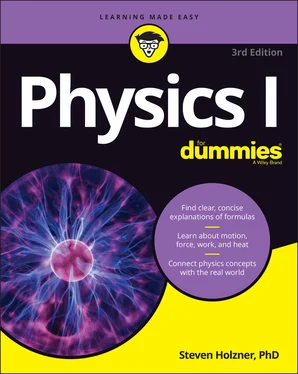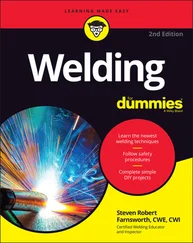Steven Holzner - Physics I For Dummies
Здесь есть возможность читать онлайн «Steven Holzner - Physics I For Dummies» — ознакомительный отрывок электронной книги совершенно бесплатно, а после прочтения отрывка купить полную версию. В некоторых случаях можно слушать аудио, скачать через торрент в формате fb2 и присутствует краткое содержание. Жанр: unrecognised, на английском языке. Описание произведения, (предисловие) а так же отзывы посетителей доступны на портале библиотеки ЛибКат.
- Название:Physics I For Dummies
- Автор:
- Жанр:
- Год:неизвестен
- ISBN:нет данных
- Рейтинг книги:3 / 5. Голосов: 1
-
Избранное:Добавить в избранное
- Отзывы:
-
Ваша оценка:
- 60
- 1
- 2
- 3
- 4
- 5
Physics I For Dummies: краткое содержание, описание и аннотация
Предлагаем к чтению аннотацию, описание, краткое содержание или предисловие (зависит от того, что написал сам автор книги «Physics I For Dummies»). Если вы не нашли необходимую информацию о книге — напишите в комментариях, мы постараемся отыскать её.
Physics I For Dummies
Physics I For Dummies
Physics I For Dummies — читать онлайн ознакомительный отрывок
Ниже представлен текст книги, разбитый по страницам. Система сохранения места последней прочитанной страницы, позволяет с удобством читать онлайн бесплатно книгу «Physics I For Dummies», без необходимости каждый раз заново искать на чём Вы остановились. Поставьте закладку, и сможете в любой момент перейти на страницу, на которой закончили чтение.
Интервал:
Закладка:
 At its root, physics is all about becoming aware of your world and using mental and mathematical models to explain it. The gist of physics is this: You start by making an observation, you create a model to simulate that situation, and then you add some math to fill it out — and voilà! You have the power to predict what will happen in the real world. All this math exists to help you see what happens and why.
At its root, physics is all about becoming aware of your world and using mental and mathematical models to explain it. The gist of physics is this: You start by making an observation, you create a model to simulate that situation, and then you add some math to fill it out — and voilà! You have the power to predict what will happen in the real world. All this math exists to help you see what happens and why.
In this section, we explain how real-world observations fit in with the math. The later sections take you on a brief tour of the key topics that comprise basic physics.
Observing the world
You can observe plenty going on around you in your complex world. Leaves are waving, the sun is shining, light bulbs are glowing, cars are moving, computer printers are printing, people are walking and riding bikes, streams are flowing, and so on. When you stop to examine these actions, your natural curiosity gives rise to endless questions such as these
Why do I slip when I try to climb that snowbank?
How distant are other stars, and how long would it take to get there?
How does an airplane wing work?
How can a thermos flask keep hot things warm and keep cold things cool?
Why does an enormous cruise ship float when a paper clip sinks?
Why does water roll around when it boils?
Any law of physics comes from very close observation of the world, and any theory that a physicist comes up with has to stand up to experimental measurements. Physics goes beyond qualitative statements about physical things — “If I push the child on the swing harder, then she swings higher,” for example. With the laws of physics, you can predict precisely how high the child will swing.
Making predictions
Physics is simply about modeling the world (although an alternative viewpoint claims that physics actually uncovers the truth about the workings of the world; it doesn’t just model it). You can use these mental models to describe how the world works: how blocks slide down ramps, how stars form and shine, how black holes trap light so it can’t escape, what happens when cars collide, and so on.
When these models are first created, they sometimes have little to do with numbers; they just cover the gist of the situation. For example, a star is made up of this layer and then that layer, and as a result, this reaction takes place, followed by that one. And pow! — you have a star. As time goes on, those models become more numeric, which is where physics students sometimes start having problems. Physics class would be a cinch if you could simply say, “That cart is going to roll down that hill, and as it gets toward the bottom, it’s going to roll faster and faster.” But the story is more involved than that — not only can you say that the cart is going to go faster, but in exerting your mastery over the physical world, you can also say how much faster it’ll go.
There’s a delicate interplay between theory, formulated with math, and experimental measurements. Often experimental measurements not only verify theories but also suggest ideas for new theories, which in turn suggest new experiments. Both feed off each other and lead to further discovery.
Many people approaching this subject may think of math as something tedious and overly abstract. However, in the context of physics, math comes to life. A quadratic equation may seem a little dry, but when you’re using it to work out the correct angle to fire a rocket at for the perfect trajectory, you may find it more palatable! Chapter 2explains all the math you need to know to perform basic physics calculations.
Reaping the rewards
So what are you going to get out of physics? If you want to pursue a career in physics or in an allied field such as engineering, the answer is clear: You’ll need this knowledge on an everyday basis. But even if you’re not planning to embark on a physics-related career, you can get a lot out of studying the subject. You can apply much of what you discover in an introductory physics course to real life:
In a sense, all other sciences are based upon physics. For example, the structure and electrical properties of atoms determine chemical reactions; therefore, all of chemistry is governed by the laws of physics. In fact, you could argue that everything ultimately boils down to the laws of physics!
Physics does deal with some pretty cool phenomena. Many videos of physical phenomena have gone viral on YouTube; take a look for yourself. Do a search for “non-Newtonian fluid,” and you can watch the creeping, oozing dance of a cornstarch/water mixture on a speaker cone.
More important than the applications of physics are the problem-solving skills it arms you with for approaching any kind of problem. Physics problems train you to stand back, consider your options for attacking the issue, select your method, and then solve the problem in the easiest way possible.
Observing Objects in Motion
Some of the most fundamental questions you may have about the world deal with objects in motion. Will that boulder rolling toward you slow down? How fast do you have to move to get out of its way? (Grab your calculator… .) Motion was one of the earliest explorations of physics.
When you take a look around, you see that the motion of objects changes all the time. You see a motorcycle coming to a halt at a stop sign. You see a leaf falling and then stopping when it hits the ground, only to be picked up again by the wind. You see a pool ball hitting other balls in just the wrong way so that they all move without going where they should. Part 1of this book handles objects in motion — from balls to railroad cars and most objects in between. In this section, we introduce motion in a straight line, rotational motion, and the cyclical motion of springs and pendulums.
Measuring speed, direction, velocity, and acceleration
Speeds are big with physicists — how fast is an object going? Thirty-five miles per hour not enough? How about 3,500? No problem when you’re dealing with physics. Besides speed, the direction an object is going is important if you want to describe its motion. If the home team is carrying a football down the field, you want to make sure that they’re going in the right direction.
When you put speed and direction together, you get a vector — the velocity vector. Vectors are a very useful kind of quantity. Anything that has both size and direction is best described with a vector. Vectors are often represented as arrows, where the length of the arrow tells you the magnitude (size), and the direction of the arrow tells you the direction. For a velocity vector, the length corresponds to the speed of the object, and the arrow points in the direction the object is moving. (To find out how to use vectors, head to Chapter 4.)
Everything has a velocity, so velocity is great for describing the world around you. Even if an object is at rest with respect to the ground, it’s still on the Earth, which itself has a velocity. (And if everything has a velocity, it’s no wonder physicists keep getting grant money — somebody has to measure all that motion.)
If you’ve ever ridden in a car, you know that velocity isn’t the end of the story. Cars don’t start off at 60 miles per hour; they have to accelerate until they get to that speed. Like velocity, acceleration has not only a magnitude but also a direction, so acceleration is a vector in physics as well. We cover speed, velocity, and acceleration in Chapter 4.
Round and round: Rotational motion
Интервал:
Закладка:
Похожие книги на «Physics I For Dummies»
Представляем Вашему вниманию похожие книги на «Physics I For Dummies» списком для выбора. Мы отобрали схожую по названию и смыслу литературу в надежде предоставить читателям больше вариантов отыскать новые, интересные, ещё непрочитанные произведения.
Обсуждение, отзывы о книге «Physics I For Dummies» и просто собственные мнения читателей. Оставьте ваши комментарии, напишите, что Вы думаете о произведении, его смысле или главных героях. Укажите что конкретно понравилось, а что нет, и почему Вы так считаете.












